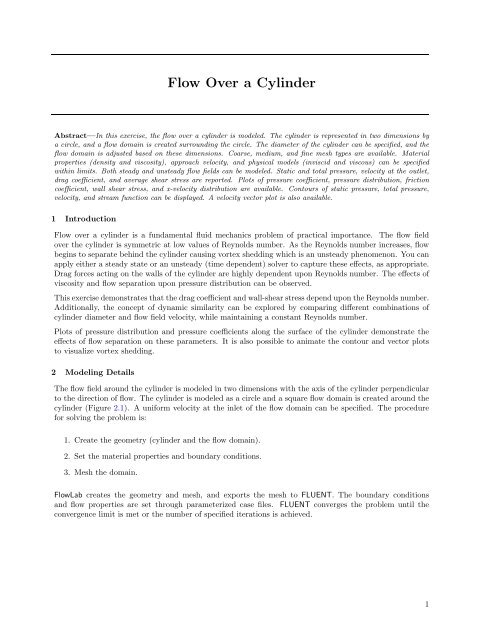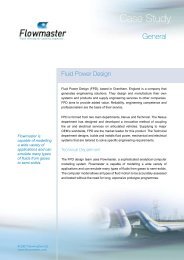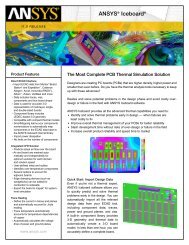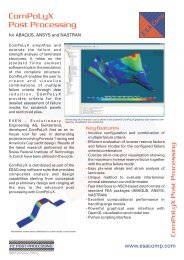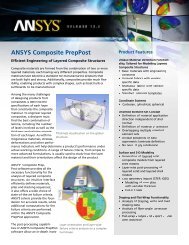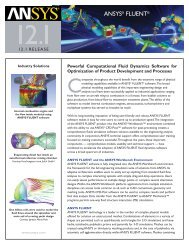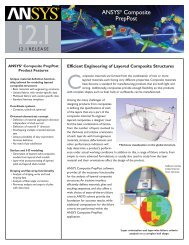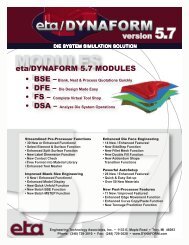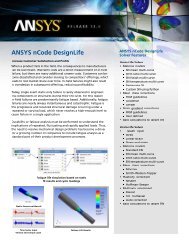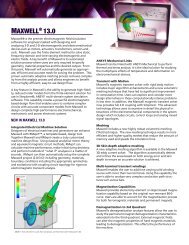Flow Over a Cylinder - PhilonNet Engineering Solutions
Flow Over a Cylinder - PhilonNet Engineering Solutions
Flow Over a Cylinder - PhilonNet Engineering Solutions
Create successful ePaper yourself
Turn your PDF publications into a flip-book with our unique Google optimized e-Paper software.
<strong>Flow</strong> <strong>Over</strong> a <strong>Cylinder</strong><br />
Abstract—In this exercise, the flow over a cylinder is modeled. The cylinder is represented in two dimensions by<br />
a circle, and a flow domain is created surrounding the circle. The diameter of the cylinder can be specified, and the<br />
flow domain is adjusted based on these dimensions. Coarse, medium, and fine mesh types are available. Material<br />
properties (density and viscosity), approach velocity, and physical models (inviscid and viscous) can be specified<br />
within limits. Both steady and unsteady flow fields can be modeled. Static and total pressure, velocity at the outlet,<br />
drag coefficient, and average shear stress are reported. Plots of pressure coefficient, pressure distribution, friction<br />
coefficient, wall shear stress, and x-velocity distribution are available. Contours of static pressure, total pressure,<br />
velocity, and stream function can be displayed. A velocity vector plot is also available.<br />
1 Introduction<br />
<strong>Flow</strong> over a cylinder is a fundamental fluid mechanics problem of practical importance. The flow field<br />
over the cylinder is symmetric at low values of Reynolds number. As the Reynolds number increases, flow<br />
begins to separate behind the cylinder causing vortex shedding which is an unsteady phenomenon. You can<br />
apply either a steady state or an unsteady (time dependent) solver to capture these effects, as appropriate.<br />
Drag forces acting on the walls of the cylinder are highly dependent upon Reynolds number. The effects of<br />
viscosity and flow separation upon pressure distribution can be observed.<br />
This exercise demonstrates that the drag coefficient and wall-shear stress depend upon the Reynolds number.<br />
Additionally, the concept of dynamic similarity can be explored by comparing different combinations of<br />
cylinder diameter and flow field velocity, while maintaining a constant Reynolds number.<br />
Plots of pressure distribution and pressure coefficients along the surface of the cylinder demonstrate the<br />
effects of flow separation on these parameters. It is also possible to animate the contour and vector plots<br />
to visualize vortex shedding.<br />
2 Modeling Details<br />
The flow field around the cylinder is modeled in two dimensions with the axis of the cylinder perpendicular<br />
to the direction of flow. The cylinder is modeled as a circle and a square flow domain is created around the<br />
cylinder (Figure 2.1). A uniform velocity at the inlet of the flow domain can be specified. The procedure<br />
for solving the problem is:<br />
1. Create the geometry (cylinder and the flow domain).<br />
2. Set the material properties and boundary conditions.<br />
3. Mesh the domain.<br />
<strong>Flow</strong>Lab creates the geometry and mesh, and exports the mesh to FLUENT. The boundary conditions<br />
and flow properties are set through parameterized case files. FLUENT converges the problem until the<br />
convergence limit is met or the number of specified iterations is achieved.<br />
1
2.1 Geometry<br />
Figure 2.1: <strong>Flow</strong> Domain<br />
A flow domain is created surrounding the cylinder. The upstream length is 15 times the radius of the<br />
cylinder, and the downstream length is 40 times the radius of the cylinder. The width of the flow domain is<br />
50 times the radius of the cylinder. To facilitate meshing, a square with a side length of six times the radius<br />
of the cylinder is created around the cylinder. The square is split into four pieces as shown in Figure 2.1.<br />
2.2 Mesh<br />
Coarse, medium, and fine mesh types are available. Mesh density varies based upon the assigned Refinement<br />
Factor.<br />
The Refinement Factor values for the mesh densities are given in Table 2.1.<br />
Mesh Density Refinement Factor<br />
Fine 1<br />
Medium 1.3<br />
Coarse 1.69<br />
Table 2.1: Refinement Factor<br />
2 c○ Fluent Inc. [<strong>Flow</strong>Lab 1.2], April 16, 2007
Using the Refinement Factor, First Cell Height is calculated with the following formula:<br />
F irst Cell Height = Refinement F actor<br />
� Y plus × (Characteristic Length 0.125 × V iscosity 0.875 )<br />
(0.199 × V elocity 0.875 × Density 0.875 )<br />
Reynolds number is used to determine Yplus. Yplus values for turbulent flow conditions are summarized<br />
in Table 2.2.<br />
Reynolds Number <strong>Flow</strong> Regime Yplus/First Cell Height<br />
Re < 1000 Laminar First Cell Height = <strong>Cylinder</strong> Radius/24<br />
1000 ≤ Re ≤ 20000 Turbulent, Enhanced Wall Treatment Yplus < 10<br />
Re > 20000 Turbulent, Standard Wall Functions Yplus > 30<br />
Table 2.2: <strong>Flow</strong> Regime Vs. Reynolds Number<br />
The number of intervals along each edge is determined using geometric progression and the following equation:<br />
⎡<br />
Intervals = INT ⎣ Log<br />
� Edge length×(Growth ratio−1)<br />
F irst Cell Height<br />
Log(Growth ratio)<br />
�<br />
(2-1)<br />
�⎤<br />
+ 1.0<br />
⎦ (2-2)<br />
A boundary layer with 10 rows is placed at the cylinder wall using the calculated value of First Cell Height.<br />
The edges are meshed using the First Cell Height and the calculated number of intervals. The entire domain<br />
is meshed using a map scheme (Figure 2.2).<br />
Figure 2.2: Mesh Generated by <strong>Flow</strong>Lab<br />
c○ Fluent Inc. [<strong>Flow</strong>Lab 1.2], April 16, 2007 3
2.3 Physical Models for FLUENT<br />
The user interface updates based upon whether the steady or unsteady solver is selected. The time step<br />
size, the number of iterations per time step, the total number of time steps, and the convergence limit for<br />
each time step must be specified if the unsteady solver is used. The total number of iterations and the<br />
convergence limit must be specified if the steady solver is used.<br />
Based on the Reynolds number, the following physical models are recommended:<br />
Re < 1000 Laminar flow<br />
1000 ≤ Re ≤ 10000 Low Reynolds number k − ɛ model<br />
Re > 10000 k − ɛ model<br />
Table 2.3: Physical Models Based on Reynolds Number<br />
If turbulence is selected in the Physics form of the Operation menu, the appropriate turbulence model and<br />
wall treatment is applied based upon the Reynolds number.<br />
2.4 Material Properties<br />
The default fluid material is water. The following material properties can be specified:<br />
• Density<br />
• Viscosity<br />
Other materials such as Air, Glycerin, and a User Defined fluid can also be selected.<br />
2.5 Boundary Conditions<br />
The following boundary conditions can be specified:<br />
• Inlet velocity<br />
• Wall roughness *<br />
* To be specified only when the flow is modeled as turbulent.<br />
The following boundary conditions are assigned in FLUENT.<br />
Boundary Assigned As<br />
<strong>Cylinder</strong> Wall<br />
Inlet Velocity inlet<br />
Side boundaries Periodic<br />
Outlet Pressure outlet<br />
Table 2.4: Boundary Conditions Assigned in FLUENT<br />
4 c○ Fluent Inc. [<strong>Flow</strong>Lab 1.2], April 16, 2007
2.6 Solution<br />
The mesh is exported to FLUENT along with the physical properties and the initial conditions specified.<br />
The material properties and the initial conditions are read through the case file. The frequency at which<br />
the results file (neutral file) is saved is written in the journal file file for the unsteady solver using the<br />
execute command. When the solution is converged or the specified number of iterations is met, FLUENT<br />
writes the case and data files. GAMBIT reads the neutral and .xy plot files for postprocessing.<br />
3 Scope and Limitations<br />
<strong>Flow</strong>Lab automatically sets the time step size such that 50 time iterations are performed in one shedding<br />
cycle. Increasing the time step size may lead to incorrect predictions. It is recommended to use at least 20<br />
time iterations for one cycle of vortex shedding.<br />
Enhanced wall treatment is used for turbulent flow conditions to predict the drag coefficient accurately for<br />
Reynold’s numbers between 1000 to 5000. For a Reynolds number higher than 5000, the cell count and the<br />
simulation run time increases exponentially. To reduce simulation run time at higher Reynold’s numbers,<br />
standard wall functions were imposed at Reynolds number greater than 20000. However, standard wall<br />
functions may lead to inaccurate drag predictions at these higher Reynolds numbers.<br />
Difficulty in obtaining convergence or poor accuracy may result if input values are used outside the upper<br />
and lower limits suggested in the problem overview.<br />
4 Exercise Results<br />
4.1 Reports<br />
The following reports are available:<br />
• Static pressure difference<br />
• Total pressure difference<br />
• Average velocity at the outlet<br />
• Total drag coefficient on the cylinder<br />
• Average shear stress on the cylinder *<br />
* Available only for viscous flow.<br />
4.2 XY Plots<br />
The plots reported by <strong>Flow</strong>Lab include:<br />
• Residuals<br />
• Pressure coefficient distribution over cylinder<br />
• Pressure distribution over cylinder<br />
• X-velocity distribution along center line<br />
• Friction coefficient distribution *<br />
• CD history<br />
c○ Fluent Inc. [<strong>Flow</strong>Lab 1.2], April 16, 2007 5
• CL history<br />
• X-wall shear distribution over cylinder *<br />
• Wall Yplus distribution **<br />
* Available only for viscous flow.<br />
** Available only when the flow is modeled as turbulent.<br />
Figure 4.1 represents the distribution of pressure coefficient over the cylinder.<br />
4.3 Contour Plots<br />
Figure 4.1: Pressure Coefficient Distribution at Re = 150<br />
Contours of static pressure, total pressure, velocity, and stream function can be displayed. A velocity vector<br />
plot is also available. All contour plots can be animated if the time dependent solver was used to converge<br />
a solution. Contours of velocity magnitude, x-velocity, y-velocity, turbulence intensity and dissipation rate,<br />
stream function, and temperature can be displayed.<br />
Figure 4.2 represents velocity contours at a Reynolds number of 150, showing a time dependent solution.<br />
6 c○ Fluent Inc. [<strong>Flow</strong>Lab 1.2], April 16, 2007
5 Verification of Results<br />
Figure 4.2: Velocity Contours for Re = 150 at time = 4000 s<br />
Table 5.1 represents predicted drag coefficient as a function of Reynolds number. These results were obtained<br />
using default settings for geometry and material properties with the fine mesh option. The desired Reynolds<br />
number was obtained by varying the inlet velocity.<br />
Re Computed Drag Experimental<br />
Coefficient Results [1]<br />
1 14.87 13.0<br />
40 1.715 1.8<br />
150 1.33 1.5<br />
500 1.35 1.2<br />
1000 1.115 0.9<br />
5000 1.021 0.98<br />
1e06 0.27 0.25<br />
Table 5.1: Computed Vs. Experimental Values Drag Coefficient<br />
The frequency of vortex shedding behind the cylinder is characterized by the Strouhal number, given by:<br />
St = fD<br />
U∞<br />
c○ Fluent Inc. [<strong>Flow</strong>Lab 1.2], April 16, 2007 7<br />
(5-1)
where,<br />
f = frequency of vortex shedding<br />
U∞ = approach velocity of the fluid<br />
D = diameter of the cylinder<br />
Strouhal number verification has been performed for a Reynolds number of 150 with a cylinder diameter<br />
0.1 m and an inlet velocity of 0.0015 m/s. For a Reynolds number of 150, the experimentally value of the<br />
Strouhal number is approximately 0.172 [2]. The time period of the flow oscillation predicted by <strong>Flow</strong>Lab<br />
is approximately 385 s, which is evaluated by plotting the lift history over the cylinder (Figure 5.1). The<br />
numerically predicted value of Strouhal number for this case is 0.173, which differs by 0.64% from the<br />
experimentally determined value.<br />
6 Sample Problems<br />
6.1 Inviscid Case<br />
Figure 5.1: Time History of Lift Coefficient<br />
1. Run time dependent cases using the inviscid option for several velocity values.<br />
2. Plot pressure coefficient versus position and compare with theory.<br />
3. Explain how and why the local pressure varies around the sides of the cylinder.<br />
4. What is the drag force acting on the cylinder? How is it determined?<br />
8 c○ Fluent Inc. [<strong>Flow</strong>Lab 1.2], April 16, 2007
6.2 Viscous (Viscid) Case<br />
1. Set the Reynolds number to 150 and run a time dependent case using the viscous flow option.<br />
2. Compare predicted drag coefficient with the corresponding theoretical value.<br />
3. How does pressure coefficient distribution vary between the viscid and inviscid cases?<br />
4. Plot velocity vectors and evaluate the flow pattern around the cylinder.<br />
5. Compare the drag coefficient values with experimental data or correlation over a Reynolds number<br />
range of 1 to 1.0e+6.<br />
6. Observe velocity vectors as Reynolds number increases.<br />
7. Explain why the pressure distribution profile flattens out at the back of the cylinder, and compare<br />
the pressure distribution profile with the velocity vector field assessing the region of flow separation.<br />
8. Animate the velocity contour results and review vortex shedding behavior.<br />
7 Reference<br />
[1] Anderson, J.D., “Fundamentals of Aerodynamics”, 2 nd Ed., Ch. 3: pp. 229.<br />
[2] Shames, I. H., “Mechanics of Fluid”, 3 rd Ed., Ch. 13: pp. 669-675.<br />
c○ Fluent Inc. [<strong>Flow</strong>Lab 1.2], April 16, 2007 9


